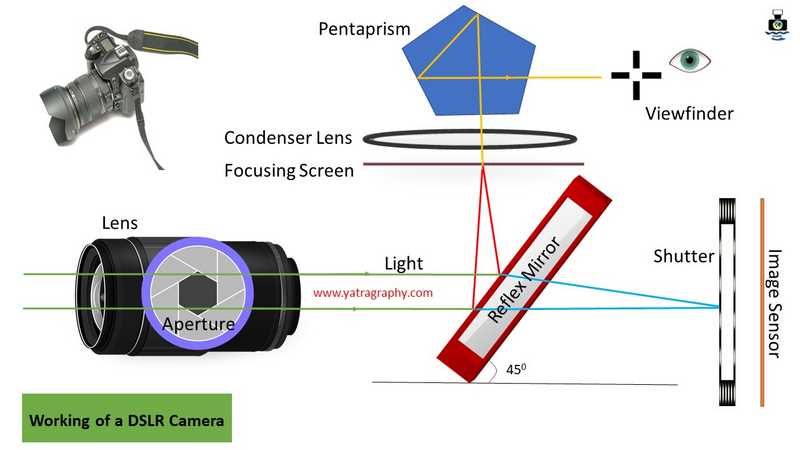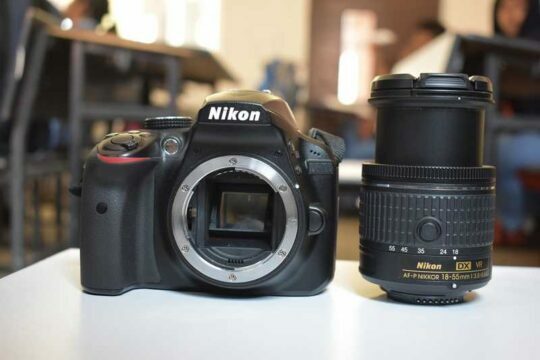DSLR, or Digital Single Lens Reflex, is a very popular type of camera used by photographers, videographers and hobbyists around the world today.
This camera is an improved version of the old SLR camera that was launched in the market in 1991.
DSLR cameras have interchangeable lenses and have a digital sensor for taking photos.
You can understand that what is done by the roll of film in old fashioned SLR cameras is done by the digital sensor in today’s DSLR.
Although today and tomorrow is the era of mobile photography, DSLR. There is a camera with which you can take great pictures.
Today in this talk we will learn what is a DSLR camera, how it works, how to use it, advantages and disadvantages?
What is a DSLR camera? What is DSLR Camera (Full Form and Meaning in Hindi)
The full form of DSLR camera is Digital Single Lens Reflex and its Hindi meaning is Digital Single Lens Reflex.
Here reflex means reflection.
It is called a digital single lens reflex camera because this camera uses only one lens for viewing/composing and shooting.
This camera then uses a reflex mechanism, which is a reflection process to reflect light from the lens towards the viewfinder.
Above the lens is the viewfinder of the camera and you need to know where you can see the scene you need to photograph.
What are the main components of a DSLR camera? DSLR Camera Parts

You will see this picture showing the main parts inside a DSLR, they are as follows.
1. Objective lenses
It is connected directly to the camera, and with its help, external light enters the camera.
There are different types of lenses with different functions and you can learn more about it in this article – How many types of lenses are there?
2. Diaphragm diaphragm
This is a hole provided in the lens through which the light entering can be controlled.
Different types of lenses have different aperture sizes written on the lens.
3. Reflex mirror reflecting the mirror
A reflective mirror is a mirror that reflects incoming light and is placed at an angle of 45 degrees.
4. Shutter Shutter
In front of the camera sensor is a curtain that controls incoming light, called the shutter.
Normally it remains closed and when you press the camera, this shutter opens and the light falls directly on the sensor and the picture is taken.
This clicking sound is the opening and closing of the shutter.
5. Image sensor Image sensor
The sensor is the heart of the camera, with the help of which the photo is created.
It contains millions of photosensitive elements called pixels.
We wrote a very detailed article about how a sensor creates a photo, which you can see here – What is a Camera Sensor?
6. Focus screen Focus screen
Think of it as a type of lens that allows you to clearly see your photo in the viewfinder.
The focus screen shows you exactly what you want to capture, and with its help, you can create a better shot.
7. Condenser lens Condenser lens
It is a combination of two convex lenses, with the help of which the light reflected from the reflex mirror is kept in a straight line.
8. Pentaprism Pentaprism
It is a 5-angle reflecting prism that bends the direct light coming from the condenser lens at a 90-degree angle.
Its angles are designed in such a way that it bends incoming light twice by 90 degrees, turning it into a straight line that eventually hits the viewfinder.
9. Viewfinder Viewfinder
The viewfinder is the part of the camera that allows us to see and create the image we need to capture.
Note here that every time you look through the viewfinder, you are not looking at the scene, but at its reflection captured by the lens.
This is the same image created by the focus screen and displayed in the viewfinder.
These are the parts of a DSLR camera, now tell us how a DSLR camera works?
How does a DSLR camera work? How does a DSLR camera work?

You look into the camera’s viewfinder and the scene you want to capture is exactly what you see in the viewfinder.
Here, light falls on the scene or object and enters the camera through the lens and onto the reflex mirror.
The light bounces off the reflex mirror and travels upwards and passes through the focusing screen and condenser lens and onto the pentaprism (see image above).
A pentaprism doubles the incoming vertical light, turns it into horizontal light, and sends it directly into the viewfinder so you can see the view of the subject.
After framing the picture, when you need to take the picture, you press the shutter button and when the click is finished, two things happen –
- The first reflex mirror is raised so that the incoming light falls directly on the shutter.
- After that, the shutter is raised and the incoming light falls directly on the image sensor.
Remember here that you can control the shutter release and rise time, which is called shutter speed. We wrote a very detailed article about this, which you can see here – What is shutter speed?
Then, after the shutter has been open for a set amount of time, it closes automatically, and then the reflex mirror also snaps back into place, stopping light from hitting the sensor.
It captures and records the light falling on the image sensor at certain intervals and uses the same information to create a photo, which is then transferred to the camera’s memory card.
All this is done in less than seconds.
Features of a DSLR camera Advantages of a DSLR camera
DSLR cameras are very popular among photographers, videographers and hobbyists.
Tell us about some of the features of a DSLR camera.
The quality of a DSLR camera is much better than that of a smartphone.
This is because their image sensor size is much larger than that of smartphones and it has a lot of settings to help you get a good shot.
2. Using the lens. Using lenses on a DSLR camera
A wide variety of lenses can be used with a DSLR camera, which is its biggest feature.
This means you can choose the right lens for your subject and scene.
For example, if you want to take a landscape photo, you can choose a wide-angle lens, similarly, if you want to take portraits, you can choose a close-up prime lens.
There are a variety of lenses available in the market that can help you take great photos.
3. Large sensor of a DSLR camera. A large sensor in a DSLR camera
As I mentioned earlier, a DSLR has a much larger sensor than a mobile phone to capture more light.
More light means better quality and detailed photos even in low light.
4. Manual adjustment and control Manual adjustment and control
On a DSLR camera, you can manually control exposure using shutter speed, aperture, and ISO.
By controlling the exposure and fine-tuning it, you can take unique photos.
For example, if you want to take a photo of a very fast-moving object, for example, a bird in flight, then you can freeze the movement by choosing a faster shutter speed and prevent the blurring of the photo, which happens with a mobile camera. Can’t be done.
Photographers who know a little about manual settings of DSLR cameras can take great photos with its help.
You can also get such manual controls by installing apps on mobile cameras, but they are far behind the settings of a DSLR camera.
5. Strength Endurance
The design of the DSLR camera is different from other cameras and it looks very powerful.
If you buy a camera that’s slightly above the mid-range, you’ll get water and dust resistance.
Therefore, a DSLR camera can be used in different shooting conditions depending on the needs of the scene.
6. Use of various types of accessories. DSLR camera accessories
Another great feature of DSLR camera is that you can use different accessories like flash, tripod, lenses, filters etc.
Using these accessories will greatly enhance your photography experience and allow you to be more creative with your photos.
Disadvantages of a DSLR camera Disadvantages of a DSLR camera
Although any DSLR camera has many advantages, it has some disadvantages that we would like to talk about now.
1. Size and weight Size and weight
While on the one hand DSLR camera is considered to be very powerful, on the other hand its big size and weight is also its main drawback.
If you compare it to a regular smartphone and any digital or mirrorless camera, a DSLR is very heavy.
This makes it difficult to carry any DSLR Camera everywhere, especially when you have to travel a lot.
2. Complexity is complexity
Using a DSLR is beyond the reach of the average person as it is very complicated.
You’ve probably noticed that a common point-and-shoot camera or smartphone has automatic settings ready, but to get a good shot on a DSLR, you need manual control.
Therefore, the initial period is very difficult for new photographers.
It is important to know and understand all the features and settings of a DSLR before using it, which takes a lot of time.
While a DSLR camera is great for stills, it loses in the video department.
This is because they are designed specifically for photography and do not have advanced features related to video, such as stabilization or better autofocus.
Although these days there are a lot of such cameras that come in the middle and high range, they can also do very good videography (Canon EOS 90D), but you will have to spend more money for them.
In my experience, a smartphone camera is better than a DSLR camera for videography in good light because it has more advanced features.
4. Need for accessories Demand for accessories
There are many types of accessories that can be used with a DSLR camera, and this is one of its disadvantages.
This is because if you only buy the camera body, you will not see any benefit, but you will have to buy the lens separately, only then you can shoot anywhere.
So, over time, you’ll find that you’ll need different types of lights and tripods, adding to your overall costs.
5. High prices High price
If you are a simple clicker, nowadays you can shoot even on a ₹5000 phone and there is no need to buy expensive DSLR cameras.
Back in the day, when phone cameras weren’t that advanced, you had to buy a camera, but these days, if you’re happy with simple photography, you don’t need those expensive cameras.
However, the price of a DSLR camera has also come down a lot these days and you can get it between Rs 25 to Rs 30,000.
Long last…
Due to its advanced features, today’s DSLR camera is very popular among professional photographers and amateurs.
In our interview, learn what a DSLR camera is, how it works, and its advantages and disadvantages.
A DSLR camera is great for professional photographers, but we can’t say it’s good for everyone.
Although many advanced features are provided in these cameras, but not everyone needs them so much because not all people have that much technical knowledge and at the same time not everyone has that much money for it. cannot spend.
You tell us by commenting whether you use a DSLR camera or another camera for photography.
Please share this helpful article as much as possible so others can benefit from it.